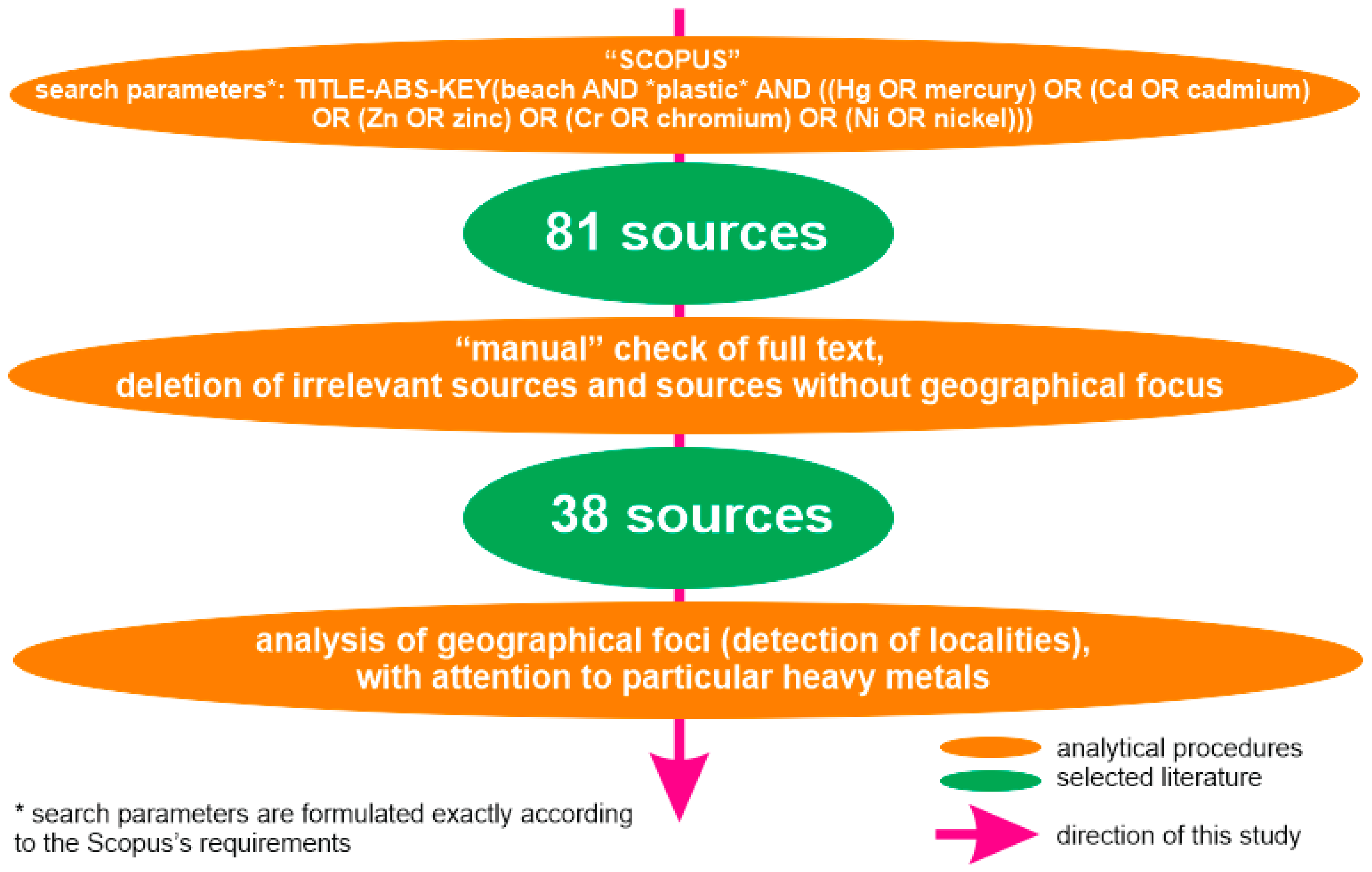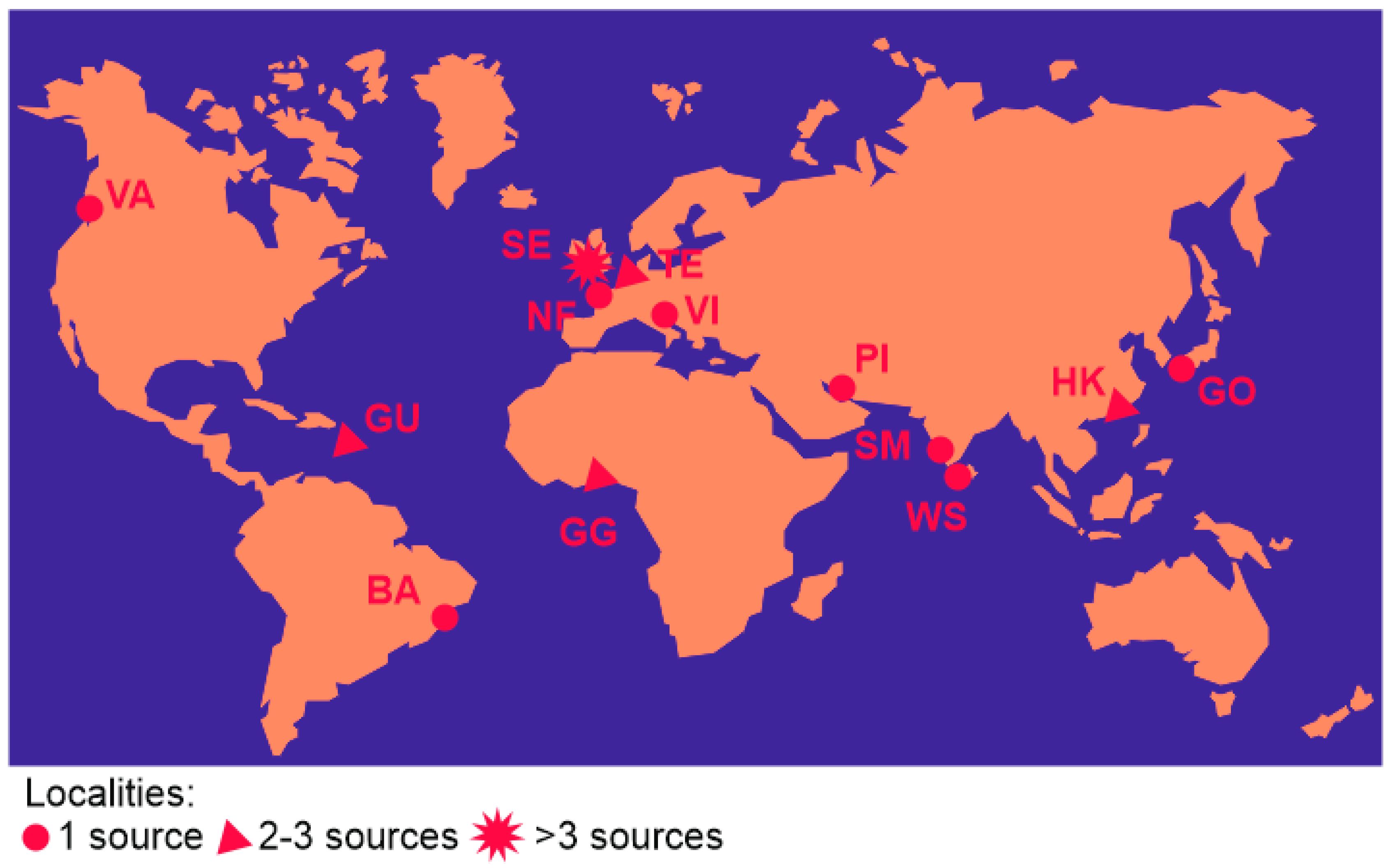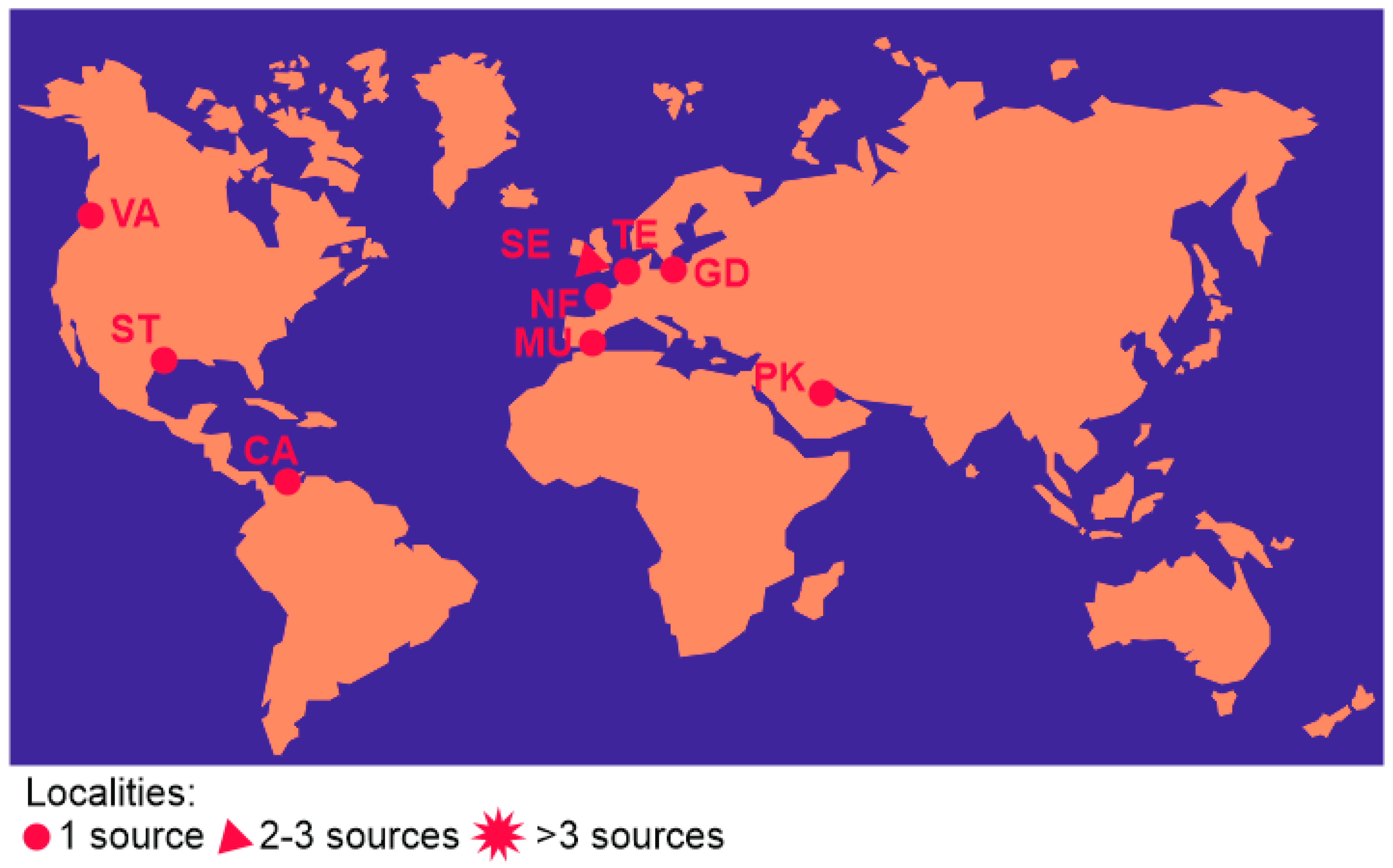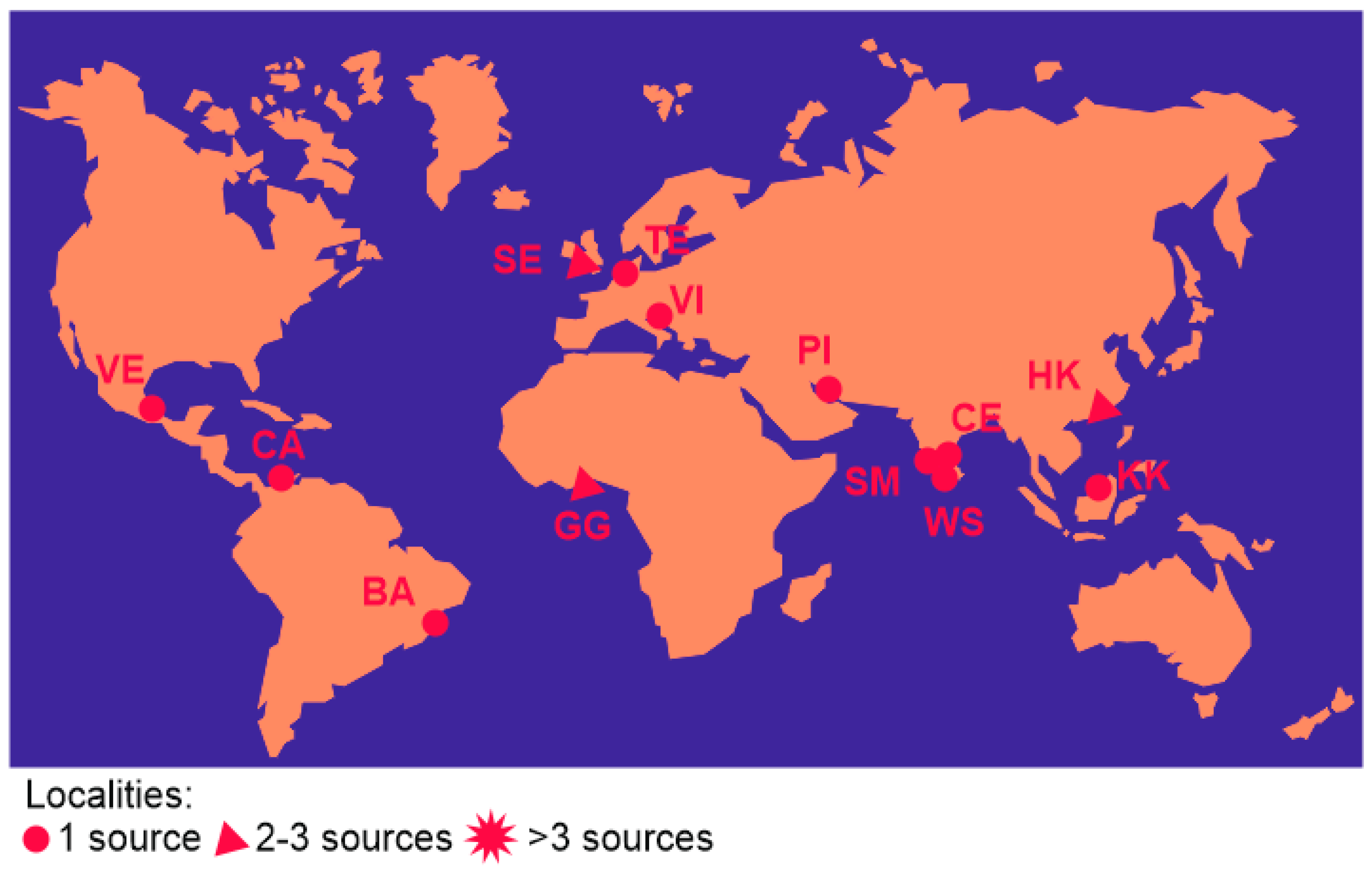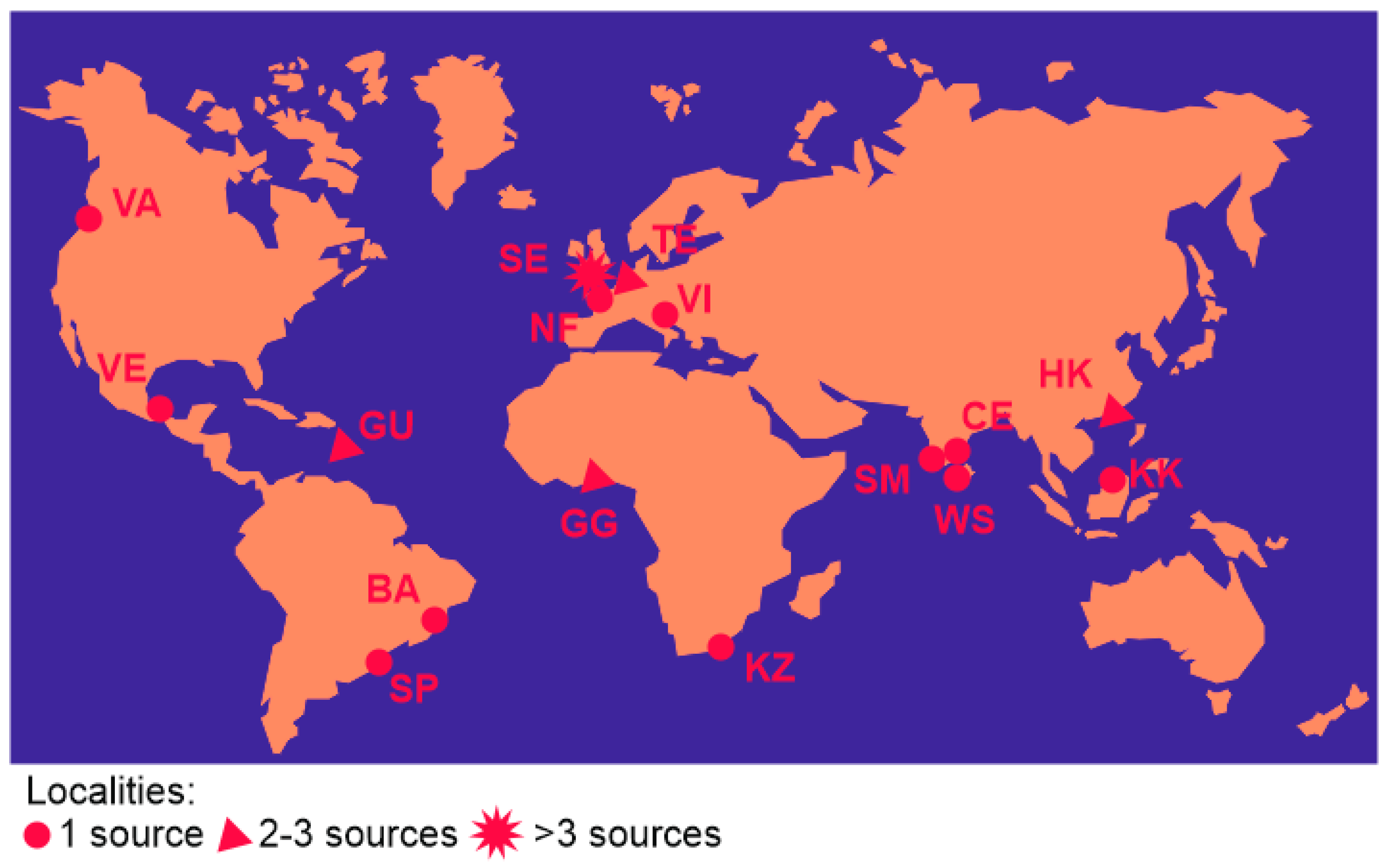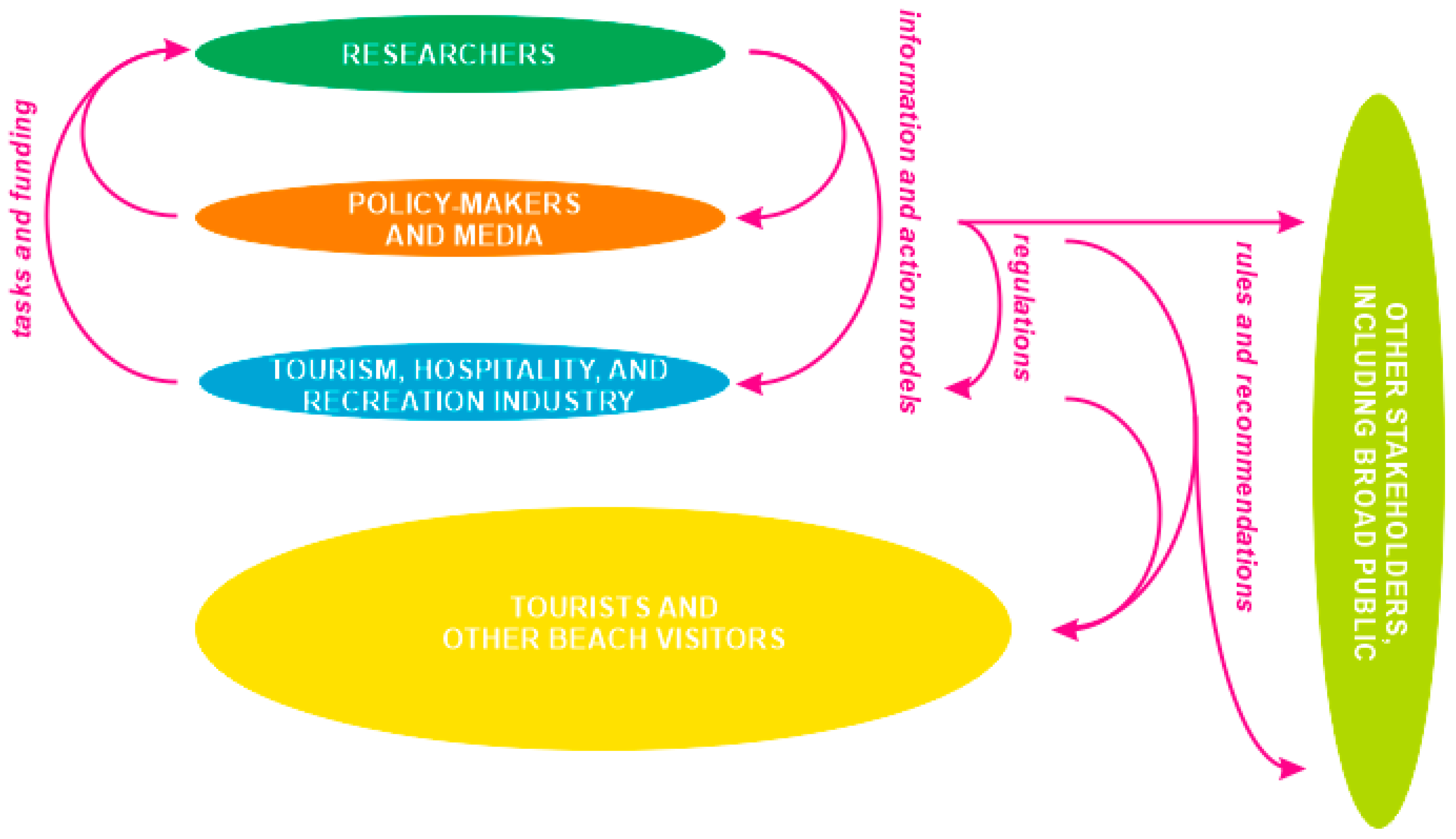1. Introduction
Plastics, which include macro-, meso-, and microplastics, have become a serious environmental challenge for contemporary society. Having various forms, compositions, and origin, plastics pollute landscapes on the planetary scale. Particularly, oceans and seas, as well as their coastal zones, have already become too affected by plastic pollution [
1,
2,
3,
4,
5,
6,
7,
8]. This challenge should not be simplified because plastics are not only “just litter”, unacceptable aesthetically, and marking anthropogenic modifications of the natural environment [
9,
10,
11], but are also a trigger of biological and chemical (often biochemical) processes with negative or unclear consequences [
12,
13,
14,
15,
16,
17,
18], as well as a contributor to carbon cycling and climate changes [
19,
20,
21,
22,
23]. The dynamics of plastics in marine environments conjugate with biological activities [
24]. In other words, marine plastic pollution is a highly-complex problem with different aspects, each of which should be addressed with significant attention.
Heavy metals associate closely with plastics in marine and coastal environments. The former can be linked to additives [
25,
26,
27] and adsorption [
28,
29,
30,
31,
32]. Indeed, bioavailability also matters [
33,
34,
35]. Such an association increases (if not multiplies) the danger from marine plastic pollution because elevated concentrations of such heavy metals as cadmium or mercury may have significant negative influences on the living nature [
36,
37,
38,
39,
40]. Special attention should be paid to beaches. On the one hand, their recreational use often leads to a voluminous supply and accumulation of plastics [
41,
42,
43,
44,
45,
46,
47], a part of which can be further transported to open marine environments. On the other hand, beaches can serve as barriers, where plastics (both touristic and non-touristic) accumulate, and, thus, contribute to the exposure of dangerous substances (also heavy metals) to visitors and biota. If so, one can expect the presence of not only plastics-related heavy metals on beaches, but also the related risks to their visitors and entire beach-based and marine ecosystems. Principally, beaches are within the global plastisphere (this has become a common term [
48,
49,
50]), and their studies in regard to plastic-associated heavy metals are related to the focus of the Anthropocene geology and geochemistry [
51,
52,
53,
54,
55]. These studies form a promising direction of geological oceanography.
Although research into beached plastics-related heavy metals started about fifteen years ago and intensified very recently, the related publications are already rather numerous, and, thus, the lines of evidence are scattered through the significant amount of sources (see review below). Taking into account the urgency of this information for environmental management, as well as for conceptual developments in the Anthropocene marine geology and geochemistry, synthesizing these lines of evidence appears to be very important. This corresponds to the current interest in environmental geochemistry (also marine and coastal) linked to tourism, hospitality, and recreation [
56,
57,
58]. Indeed, such syntheses can address different aspects of the problem. The objective of the present contribution is to provide a geographical synthesis of the literary evidence of heavy metals associated with plastics on sea beaches. The need for such a geographical emphasis is dictated by two reasons. First, tracing the spatial distribution of the considered phenomenon reveals its scale. Second, the same analysis indicate the geographical biases in the knowledge of this phenomenon, which is important for the coordination of further investigations. This work does not pretend to be a comprehensive review of the particular environmental problem taken entirely, but it aims at documenting its geographical patterns in the light of the published knowledge.
2. Materials and Methods
From the various heavy metals which may be associated with plastics on sea beaches, attention is paid in this work to cadmium (Cd), chromium (Cr), mercury (Hg), nickel (Ni), and zinc (Zn). Initially, the literature was checked, and these metals were selected because they are among the best studied and widely documented. Moreover, negative environmental consequences and the related risks from pollution by cadmium [
59], chromium [
60], mercury [
61], nickel [
62], and zinc [
63] in oceans and seas, as well as on beaches, are well-known.
The literary evidence, i.e., the information already published in international scientific journals, constitutes the material of the present study. It was collected by the “standard” procedures employed for the purposes of bibliographical surveys and reviews, which have become widespread in earth and environmental research [
57,
64,
65,
66,
67]. The bibliographical database “Scopus”, which boasts extensive coverage of the scientific literature [
68,
69], was used to collect the sources, and their subsequent check allowed information suitable for the present study to be established (
Figure 1). It should be stressed that the majority of the leading environmental journals (if not all of them) are included in “Scopus”, and this database offers quick indexation of their articles, which is important for such a quickly-grown research field as marine plastics. Moreover, “Scopus” offers a unique search engine for the quick and comprehensive collection of the literature.
A total of 38 articles devoted to plastics-associated cadmium, chromium, mercury, nickel, and zinc from beaches were found (
Table 1). The majority of them were published in the major international journals (“Marine Pollution Bulletin” was most commonly selected by the authors). Notably, about two thirds of them appeared during the past five years (especially since the beginning of the 2020s). Among them, there are articles that considered several metals and a single metal. Although almost all the sources express environmental concerns, not all articles state beach pollution by heavy metals (some works simply note the presence of plastics-related heavy metals on beaches), and it is not easy to understand which particular metal is thought to be real or potential danger in some cases (several works consider heavy metals and specify the related risks in too general words). This seems to be a normal situation for the emerging research direction, and this is why this analysis focuses on the general geographical patterns.
Methodologically, the present analysis is framed by its objective, namely providing the geographical synthesis of the available knowledge. First of all, the geographical focus of the particular articles is established. Most commonly, this is a particular locality comprising one or several closely located beaches; the affinity to countries can be easily found. After the initial analysis of the literature, it is possible to attribute some very close, even overlapping, localities to a single locality. This is also possible when one work deals with several localities. These slight modifications are necessary to map the information on a global scale. Then, the localities are specified for each of the selected heavy metals. This permits the mapping of the global distribution of cadmium, chromium, mercury, nickel, and zinc in association with plastics on beaches. Indeed, this distribution reflects the only present state of the scientific knowledge. Taking into account the necessity of special, state-of-the-art techniques for investigation of this association, it is reasonable to believe that almost all (if not all) related information can be found in the only articles published in top international journals. It’s possible incompleteness does not matter because it is among the aims of this study to judge about the degree of this incompleteness. In other words, this study focuses on mapping what is known from the literature and not what can take place in fact. The simple maps can be interpreted qualitatively to judge about the distribution of particular heavy metals associated with beached plastics. Attention is paid to two additional issues. First, the notions of environmental danger of plastics-associated heavy metals on beaches in the analyzed sources are considered. It should be stressed that the interpretations of this danger differ between the works: it is argued via comparison to some reference levels or via experiments or it is only hypothesized on the basis of too general assumptions (the latter occurs too often). This situation is expected because many works focus on the general issue of beach pollution by plastics, and heavy metals are considered “marginally”. Moreover, it appears that the comprehensive studies of heavy metal cycling in different environments polluted by plastics are yet to be done, and, thus, the only preliminary judgments of the noted danger are possible. Second, the notions of whether the industry of tourism, hospitality, and recreation contributes to the accumulation of plastics and associated heavy metals are taken into account.
3. Results
3.1. Geographical Patterns
The association of the selected heavy metals with plastics on beaches was reported for many parts of the world. Our analysis of the published data permits the registration of thirteen localities belonging to twelve countries for cadmium (
Table 2), seventeen localities belonging to fifteen countries for chromium (
Table 3), nine localities in nine countries for mercury (
Table 4), thirteen localities from twelve countries for nickel (
Table 5), and sixteen localities belonging to fourteen countries for zinc (
Table 6).
Mapping the collected literary information implies the wide geographical distribution of the beaches with plastics bearing the selected heavy metals (
Figure 2,
Figure 3,
Figure 4,
Figure 5 and
Figure 6). Although the most intensively studied locality is Southwest England in the United Kingdom, one should note the presence of such beaches in Africa, the Americas, Asia, and Europe. The previous studies were concentrated in West Europe and South and East Asia. Significant attention has been paid to South India and Sri Lanka. The majority of the localities correspond to the coasts of the Atlantic and Indian oceans. This is true for all five heavy metals (
Figure 2,
Figure 3,
Figure 5 and
Figure 6), except for mercury, for which the localities tend to concentrate along the Atlantic coasts only (
Figure 4). Zinc is the only considered heavy metal, for which an association with plastics is reported from more than one locality in Africa (
Figure 6). Nonetheless, the observed association of cadmium, chromium, mercury, nickel, and zinc with beached plastics across the globe seems to be a global phenomenon because it is found in different geographical domains, and this is true even for mercury with the least number of localities (
Figure 4).
In some cases, the concentrations of the selected heavy metals are found to be elevated enough to speculate about real or potential dangers to the local environment (
Table 1). However, it is explained above that the bases of such judgments differ and are not always clear in some cases. It should also be noted that tourist activities may be responsible for the accumulation of plastics bearing heavy metals (
Table 1).
Synthesizing the knowledge of five heavy metals associated with plastics on sea beaches allows for making two important observations. First, the scale of the problem seems to be global. Although the number of the studies was rather limited, the records from many parts of the world (
Figure 2,
Figure 3,
Figure 4,
Figure 5 and
Figure 6) and different geographical settings prove the wide distribution of the beaches with plastics bearing heavy metals, the concentrations of which often reach dangerous levels (
Table 1). Second, the five selected metals differ by the number of the studied localities (
Table 2,
Table 3,
Table 4,
Table 5 and
Table 6), with mercury as the least frequently reported (
Table 4). It cannot be excluded that these differences can be explained by the analytical difficulties of investigations differing for the selected heavy metals.
3.2. Selected Examples
For cadmium, a representative example includes the beaches of Vancouver in Canada (
Figure 2). There, Fernandes et al. [
77] examined litter from the beach surface and, particularly, reported significant concentrations of cadmium (up to 32.3 μgg
−1) in candy wrappers from recreational areas. Even higher concentrations of this metal were found there in an unidentified fragment, presumably of industrial origin. Taking into account the significance of recreational activities on some studied beaches, where more than half of the plastic litter consists of food packaging [
77], the related source of cadmium raises environmental concerns. A comparison with the “natural” levels of cadmium in beach sediments and nearby seawater is required to judge the pollution and true environmental risks.
For chromium, a notable example is the beaches of Chennai in India (
Figure 3). Initially, Suman et al. [
95] reported the absorption of trace metals, including chromium, on the surface of petroleum-based plastic debris collected from the beach surface and the upper layer of sediments. Its concentrations reach 1.11 μgg
−1, and they are relatively higher for polyamide polymers. Although the contribution of tourism and hotels may matter, the authors of this study indicated on the different origins of plastics in their case. A bit later, Ranjani et al. [
90] undertook an extensive examination of microplastics on the southeast coast of India (Chennai coast) where the upper layer of sediments was sampled. Their study proved the adsorption of chromium on plastics and multiple sources of the latter. These specialists also stressed the major role of the industry of tourism, hospitality, and recreation in the supply of plastics and its seasonal variations on several beaches. Importantly, they take into account the concentrations of heavy metals in coastal environments to be compared from those in plastics.
As an example for mercury, the Mediterranean beaches of Murcia in Spain can be considered. According to Santos-Echeandía et al. [
92] who examined different parts of these beaches, the concentration of mercury exceeds 8200 nmol kg
−1. This metal tends to associate with polyurethane and polyvinyl chloride and with black plastics. In regard to what is reported in this study, the association can be explained by both additives and absorption. Although different sources of plastics are proposed, beach recreation is among them. Importantly, it appears that plastics are able to increase concentrations of mercury higher than those in the aquatic environment, with the related effects on exposure of organisms to Hg-pollution.
A typical example for nickel can be found in Kota Kinabalu in Malaysia, where beached plastics were studied by Zahari et al. [
107] who sampled the upper layer of beach sediments. Their investigation established the concentrations of nickel up to 20 mg kg
−1. Interestingly, this metal associates with different kinds of plastics on different beaches: polypropylene in one case and polystyrene in the other case. The interpretations of the sources of plastics presented in the work by Zahari et al. [
107] leave the impression that these sources are diverse, being linked to local household activities and delivery by currents and waves; nonetheless, the contribution of beach recreation cannot be excluded. Indeed, a comparison to nickel concentrations in beach sediments and seawater will provide new insights.
For zinc, a representative example is the beaches of Shenzhen, which is attributed to the Hong Kong–Pearl River Estuary in South China. Xiang et al. [
105] reported the relatively high concentrations of zinc (>500 mg kg
−1) from plastics collected on these beaches. The experiments showed that heavy metals (including zinc) from plastics do not pose negative health effects. However, the same example implies that recreational activities contribute substantially to accumulation of Zn-rich plastics.
4. Discussion
4.1. Biases and Related Interpretations
The registered geographical patterns (
Figure 2,
Figure 3,
Figure 4,
Figure 5 and
Figure 6) do not reflect true differences in the distribution of plastics-associated heavy metals, but they reflect differences in the scope of the international research and the analytical opportunities. There are evident geographical biases. Of the biggest concern is the absence of information (at least, it was not found with this bibliographical survey) from Australia, with its long shoreline and numerous beaches. The localities tend to concentrate along the coasts of the Atlantic and Indian oceans, whereas those of the other oceans are too rare or absent. The scarcity of information from the Mediterranean appears to be intriguing.
Speaking about the noted biases highlights another, research-related issue. One would hypothesize that investigations of the association of heavy metals with plastics requires advanced analytics and significant funding, and, thus, they should concentrate in the developed countries. However, the outcomes of the present analysis of the literary information (
Table 2,
Table 3,
Table 4,
Table 5 and
Table 6) totally disprove such a hypothesis. Many localities are found in the developing countries, and they were investigated by the research teams from these countries to mark their big success in high-class research. In contrast, the records from some developed countries are scarce or absent, which questions the research agenda there. Most probably, the geographical biases should be explained by the very sporadic interest of the entire international research community to the urgent problem, which coexists on the agenda together with many other problems. Anyway, the intense studies of this problem in Southwest England [
71,
81,
87,
97,
98,
99,
100,
101,
102], Guadeloupe [
73,
74,
76], and South China [
85,
105,
106] demonstrate how this research theme can rise in relation to the particular areas.
The present synthesis implies that plastics bearing heavy metals are often supplied by the industry of tourism, hospitality, and recreation (
Table 7). The analysis of the content of the collected literature (
Table 1) also suggests that this industry is significant, but usually only one of many (local and remote) sources of plastics, and it dominates rather rarely (see also the examples given above). Moreover, the literature often suggests that the proper management of beaches, including regular cleaning and restrictions for visitors, minimizes the role of this source to a significant degree (for instance, see [
107] about the efficacy of such measures in Kota Kinabalu in Malaysia). Nonetheless, the other research has shown that the industry of tourism, hospitality, and recreation can produce voluminous amounts of plastics on beaches, which also actively “catch” plastics delivered by currents and waves. The related lines of evidence were obtained from Bali in Indonesia [
108], California in the USA [
109], Northern Sardinia in Italy [
110], Phuket in Thailand [
111], and South Australia [
112]. If so, one can assume that the knowledge of heavy metals associated with plastics on beaches due to touristic activities (
Table 7) remains very incomplete, and the problem may be significantly stronger than one can imagine. A specific issue deserving attention is the creation of artificial beaches and the modification of natural beaches for recreational purposes. Apparently, they can become new barriers for the accumulation of plastics bearing heavy metals, and, thus, the industry of tourism, hospitality, and recreation contributes to the problem indirectly, i.e., even without the supply of plastics.
The present geographical synthesis proves the global scale of the problem with the presence of heavy metals associated with beached plastics. Although its studies have remained scarce, and the number of the related localities remains rather limited (
Table 2,
Table 3,
Table 4,
Table 5 and
Table 6), cadmium (
Figure 2), chromium (
Figure 3), mercury (
Figure 4), nickel (
Figure 5), and zinc (
Figure 6) are associated with plastics on the beaches in many parts of the world. Irrespectively of whether heavy metals occur as additives or are adsorbed from outside (also from seawater), they often tend to concentrate on beaches thanks to the accumulation of various plastics. If so, the geochemical peculiarities of coastal environments experience changes. Taking into account the noted global scale of these processes, it is possible to state their contribution to the Anthropocene modification of the planetary environment. This geological interval is marked by geochemical perturbations, including those linked to heavy metals [
113,
114] and plastics [
115]. It should be stressed that beaches are actively visited by definition, as well as requiring cleanness and preservation of their natural state. Therefore, the noted geochemical changes mark the situation when the specific Anthropocene dynamics affect the specific anthropogenic environment.
4.2. Implications
Although the present work focuses on the geographical synthesis of the literary information, its outcomes also permit outlining some practical implications. The association of heavy metals (especially with dangerous concentrations) with plastics on sea beaches is a serious challenge to the industry of tourism, hospitality, and recreation, for which beaches constitute a crucial resource. The interests of beach visitors should be reflected by policy-makers and the media. These stakeholders can pose tasks (these can be simplified as the cleanness and environmental safety of beaches) and provide funding to researchers, who can only realize the scale of the problem on the global, national, and local scales. The outcomes of the related research projects should be communicated to the noted stakeholders to prescribe regulations, rules, and recommendations to organizations of tourism, hospitality, and recreation, as well as to the other stakeholders. The considered environmental challenge seems to be too complex and still too poorly understood (for instance, see the geographical biases identified above) that it cannot be addressed without “deep” involvement of the international research community (
Figure 7). As demonstrated by the present study, research teams from many countries are able to provide the related service to the contemporary society.
The undertaken analysis of the available literature has faced certain difficulties. The main difficulty is the significant heterogeneity of the published scientific information. The problem is not that the different articles consider different heavy metals and different localities. More important is that the outcomes of the particular studies are reported differently. For instance, the concentrations of heavy metals are stated either numerically in the text or only graphically on the figures, the links to different plastic types are either established or not, the real or potential dangers of particular heavy metals are often not stated, and the relative contribution of the industry of tourism, hospitality, and recreation remains unclear in many cases. The potentially demanded comparisons to concentrations of heavy metals in beach sediments and coastal waters are not found in several (if not many) works. Indeed, the manner of communication of the research outcomes cannot and should not be standardized. However, the degree of heterogeneity of the available literary information seems to be so high that it would be too difficult (most probably, impossible) to accompany the present geographical synthesis with some more detailed generalizations (alternatively, these would be incomplete and based on the chaotic information). More comprehensively, it is not only geographical syntheses that are really demanded to realize the patterns of the considered problem on the global scale. Indeed, some information can be gathered from the available literature, but only for the limited number of the localities, which makes the entire literary evidence rather imperfect.
In regard to that said above, it appears very logical to think about the creation of the open-access database for collecting the information from the research projects linked to heavy metal association with plastics on beaches. Examples of other environmental databases [
116,
117] can be considered. However, even without such ambitious initiatives, researchers can be recommended to present their results in a more systematic way. Scientists should be aware of their responsibility for the development of policy and regulations of emerging contaminants, including plastics [
118,
119]. Without the possibility of subsequent synthesizing, the portions of precious, but too particular, information lose their conceptual and practical importance. The presence of heavy metals in association with plastics on sea beaches seems to be real challenge and reason for policy-making concerns, but its understanding requires comprehensive scientific vision.
5. Conclusions
The present geographical synthesis of the literary information of heavy metals associated with plastics on sea beaches allows for making three general conclusions. First, beached plastics bearing cadmium, chromium, mercury, nickel, and zinc are present in many localities in different parts of the world, which is evidence of the global scale of the problem. Second, from the five considered heavy metals, the geographical extent of the knowledge of Hg-bearing plastics is the most limited. Third, the understanding of the problem is biased geographically: the evidence from many beaches of the world, including those where the industry of tourism, hospitality, and recreation can supply significant amounts of plastics, is scarce or absent. More generally, the outcomes of the present study widen the focus of the Anthropocene marine geochemistry.
The present study is pioneering, and, thus, it does not (and cannot) avoid limitations. First, the five heavy metals are considered. Indeed, consideration of only them is enough to outline the problem and to reveal its geographical scale. However, further investigations can also pay attention to copper, lead, and other heavy metals. Second, this work focuses on the general geographical distribution of the localities where heavy metals associate with plastics on sea beaches. Further investigations can check some other spatial regularities—e.g., the geographical relations of particular metals to particular types of plastics. However, such “advanced” study will become possible only after accumulation of additional, significant volumes of the more or less homogeneously reported information.
The present study highlights an important perspective for the current research in marine and coastal plastics, namely organizing investigations to document the regional, national, and global extent of the related problems. In other words, it seems to be worth addressing geographical aspects in such studies. A promising issue for further geographical investigations is the establishment of possible spatial relationships between plastic-related heavy metals on beaches and environmental pollution linked to the artisanal and small-scale mining of gold and other metals. It cannot be excluded that the related extractive activities are responsible for a certain amount of heavy metals adsorbed later by marine plastics, and the role of beach environments in these processes deserves close attention.
